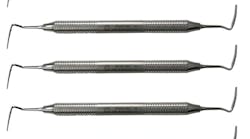I vaguely remember learning about periodontal files along with hoe and chisel scalers from my Wilkins’ textbook in dental hygiene school. I assumed these were archaic tools used in the past for periodontal instrumentation. However, I was surprised when I started working in a periodontal practice, and the periodontists I worked with used files on a regular basis, and they expected me do the same!
I was embarrassed to admit that I’d never used a periodontal file and I was not aware of the value of these instruments. Over time, I’ve become more comfortable using them and I consider them an essential component of perio therapy.
Read more from Amy Lemons
Do water flossers work? A hygienist's quest to find out
Piezoelectric vs. magnetostrictive ultrasonic scaler: What’s the difference?
Why we use perio files
Periodontal files can be used as a supplement to sickle scalers, curets, and ultrasonic instrumentation in areas that are difficult to access with traditional instrumentation techniques. Files can be used to crush or roughen a calculus deposit so it can be more easily removed with a sickle scaler or curet. They can also be used to roughen the surface of burnished calculus deposits, which facilitates removal of these deposits with a curet.1
Similar to Gracey curets, periodontal files are area specific. Each file is designed to be used on specific tooth surfaces, requiring a set of files to instrument the entire mouth. They also have a rigid shank and rounded back to facilitate subgingival use. Files have multiple straight cutting edges lined up at a 90- to 105-degree angle to the base. The most common types of periodontal files include the Hirschfeld and Orban designs. The application of these files is outlined in Table 1.1
A major difference between periodontal files and curets is how they’re adapted to the tooth surface. Periodontal files require a two-point contact, adapting the face of the working-end flat against the calculus deposit while resting the lower shank against the tooth. To avoid gouging the cementum and traumatizing the soft tissue, have the face flat against the tooth and not at an angle. This two-point contact also provides additional stability and leverage for the instrumentation stroke.1
I don’t recommend using a periodontal file on a typical prophy patient, nor do I think of them as a replacement for ultrasonic scalers and curets. However, periodontal files can be an excellent tool to have in certain situations. They can be a useful for scaling and root planing and periodontal maintenance patients, particularly those with refractory periodontitis. For example, if you have a patient with a 7 mm pocket on the facial of tooth No. 24, it’s going to be difficult to access that area with an ultrasonic scaler, and practically impossible with a curet.
In this situation, a periodontal file is perfect for removing residual calculus deposits from this area. This is also true for furcation areas and root concavities, which can be difficult to access with traditional instrumentation techniques often leading to burnished calculus deposits.
In conclusion, periodontal files can be the ideal instrument to remove calculus deposits from difficult-to-access areas and to achieve the successful outcomes of periodontal therapy you and your patients want to see.
Reference
1. Gehrig JS, Sroda R, Saccuzzo D. Fundamental of Periodontal Instrumentation & Advanced Root Instrumentation. Enhanced 8th ed. Jones & Bartlett Learning; 2019:489-491.
Amy Lemons, MEd, BSDH, RDH, has more than 10 years of experience as a dental hygienist, and she has a master’s degree in adult and higher education from the University of Oklahoma. She is currently a Clinical Assistant Professor in the Division of Periodontics at the OU College of Dentistry. She teaches preventive dentistry and periodontal instrumentation to first-year dental students.







